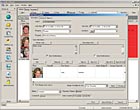Lobby Defense

Visitor management offers opportunities to implement such systems as an integrated element of the security platform. This approach allows creating a highly effective, cohesive automated and economic solution to meet current and emerging threats accordingly to protect the corporation’s assets including staff, while tightly managing the risk. Display is from iView Systems.
Visitor management in the lobby is a first line of defense, according to John O’Brien, CPP, global security manager, PTC. At PTC, its business is product development and objective is to provide clients with product lifecycle management and enterprise content management solutions.
O’Brien has been with PTC for three years and is a member of ASIS International.
“The visitor management system is a very important aspect of security at PTC. It enables us to make the lobby our first line of defense,” said O’Brien. “We know at all times who is in the building. That allows us to relay that information to the proper authorities in the event of an emergency. Also, we use the visitor management system to obtain metrics that I present to the company executives (e.g. total visitors, total temporary contractors, forgotten employee badges).
“The system allows us to look up any person who has visited the company and see how many times they have visited, who they have visited, and for how long each time.”
O’Brien’s experience matches many security directors, who just a few years ago handled visitors through a written log.
FROM PAPER LOGS
“Even three years ago, we were using paper logs, which was a time consuming process and very cumbersome when it came to looking up old visitors or obtaining metrics which was virtually impossible to do,” commented the PTC security executive. His system from EasyLobby is an integrated visitor management system, which allows the lobby personnel to assign temporary access cards to short term contractors or employees who forget their badge. “We can select, through the visitor management system, expiration dates, activation dates and types of badges with pre-set access levels,” added O’Brien.EasyLobby integrates with numerous access control systems. That’s a trend seen across products. For example, the GE Security’s Visitor Central electronic visitor management system integrates with installed access control systems. Users can create professional, customized photo visitor badges that give companies more control over visitor access than manual, paper-based visitor logs. Employees can host visitors based on their own access privileges. An audit trail tracks the exact time and location of each visitor, and the privileges can be programmed to expire at a specified date or time. The system works with GE’s Picture Perfect and Secure Perfect access control systems.
Such strategies fill the security gap. According to Felix Mira of Ingersoll Rand Security Technologies, “Over the past several years, companies have done a good job of credentialing employees and verifying and tracking access. Unfortunately, in many cases the visitor has been overlooked. That doesn’t make much sense, especially when one realizes that most major security management systems used to track employee access, also have sophisticated visitor management system.”
Added Mira, an important aspect of visitor management is the ability to maintain a list of people who are not allowed into a facility, whether for security, guardianship/custodial rights, personnel restrictions or other reasons, including those of national security. The visitor management system can require a photo and/or signature from the guest and the company can compare these items to stored information. Such verification is becoming more important for legal reasons as well as security concerns. For instance, a visitor management system can help a company doing business in the United States to further comply with HSPD-12 and the Sarbanes-Oxley Act (SOX).
With the inception of HSPD-12, the convergence of logical and physical access control is becoming mandatory. It requires a common identification credential for all federal government employees and contractors that will be used for both physical access to federally controlled facilities and logical access to information systems. Meanwhile, SOX insists that chief information officers are responsible for the security, accuracy and the reliability of the systems that manage and report the financial data.
Looking for a reprint of this article?
From high-res PDFs to custom plaques, order your copy today!





